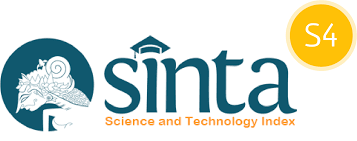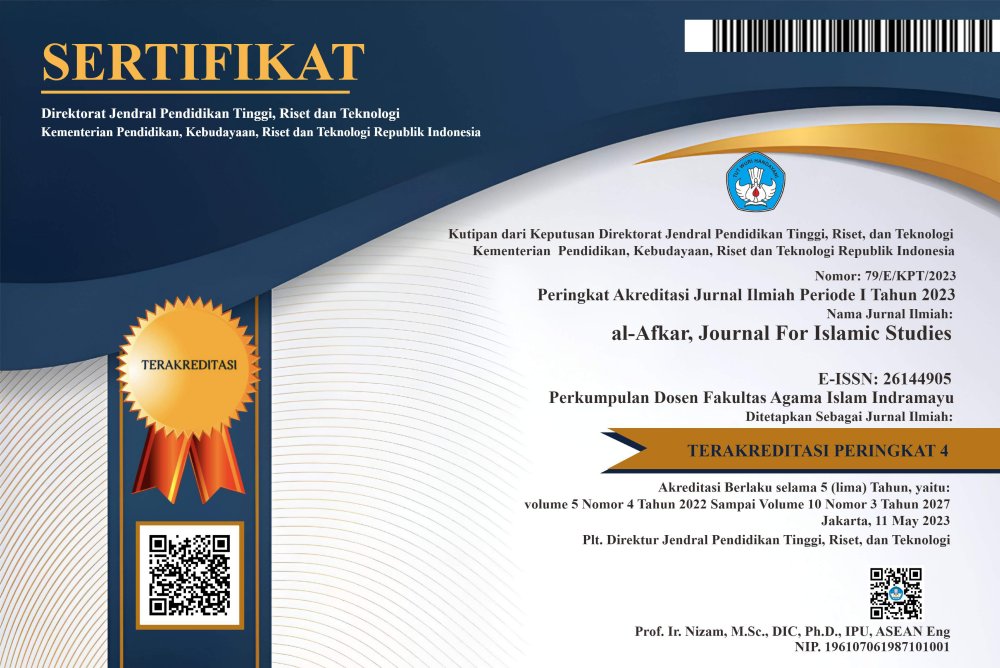Application of Al-Wujuh Wa An-Nazhair Rules and Tafsiriyah Tarjamah on Human Words in the Translation of the Ministry of Religion of the Republic of Indonesia
DOI:
https://doi.org/10.31943/afkarjournal.v7i4.1664Keywords:
Al-wujūh Wa An-Naẓhāir, Tarjamah Tafsiriyah, HumanAbstract
This research discusses a study of the rules of al-wujūh wa an-naẓāir in the tarjamah tafsiriyah regarding the word human in the Ministry of Religion's translation of the Koran. The verses of the Qur'an that were revealed in Arabic have many unique words and a variety of meanings according to the context of the verses, so it is necessary to study the meaning of these words to make it easier for Muslims to understand the verses. The rules of al-wujūh wa an-naẓāir are a study of the science of the Qur'an which discusses meaning and pronunciation. The spread of Muslims outside the Arab nation requires the translation of verses of the Qur'an into their native languages. There are two translation methods, namely literal translation and tafsiriyah translation. By formulating how to apply al-wujūh wa an-naẓāir and tarjamah tafsiriyah of the word human in the Qur'an, researchers used the maudhu'I method and a descriptive qualitative approach. The results of the research are that the mention of humans in the Qur'an is Basyar, Insan, Nas, Bani Adam with the same meaning.
Downloads
References
A.N., A. N., Mahmudulhassan, M., Marshal, F. D., Muthoifin, M., & Fadli, N. (2024). Human rights and social justice in Quranic contexts: a global trend. Legality : Jurnal Ilmiah Hukum, 32(2), 453–471. https://doi.org/10.22219/ljih.v32i2.35088
Abdul-Baqi, M. F. (1364). Mu`jam al-mufahras li alfaz al-Qur’an al-Karim. Dar al-fikr , 1981.
AN, A. N. (2013). Konsep Islamic State Amien Rais dan Nurcholish Madjid. Jurnal Substantia, 15(1), 41–52.
AN, A. N., . M., . M., & . W. (2024). Bibliometric Analysis of Islamic Education and Character Development in Religious Education Practices in Indonesia. Pakistan Journal of Life and Social Sciences (PJLSS), 22(2), 1231–1245. https://doi.org/10.57239/PJLSS-2024-22.2.0086
An, A. N., Alfian, M. Y., Saifudin, & Akhyar, S. (2021). Implementasi Metode Tafsir Tahlili Terhadap Qs Ar-Rum Ayat 30 Tentang Fitrah Manusia dalam Tafsir Azhar untuk Membendung Embrio Paham Atheis. Al-Tadabbur: Jurnal Ilmu Al Quran Dan Tafsir, 6(2). https://doi.org/10.30868/at.v6i02.2082
An, A. N., Amir, A. M., Husain, M. Z. Bin, Ismail, F. H., Sahimi, M. S. Bin, Fansuri, F., Amri, M., Arfan, F., & Rhain, A. (2025). Millennial era Islamic parenting studies: A bibliometric analysis utilizing the Scopus database. Multidisciplinary Reviews, 8(1), 1–12. https://doi.org/10.31893/multirev.2025002
AN, A. N., & Cahyo, E. D. (2023). Ushul Tafsir and Qawaid Tafsir Nusantara: A Review Of Nawawi Al Bantani’s Book Of Tafsir Marah Labid. Syariati: Jurnal Studi Al-Qur’an Dan Hukum, 8(2), 153–162. https://doi.org/10.32699/syariati.v8i2.4249
AN, A. N., & Zaglul Fitrian. (2020). PENALARAN ISTISLAHI TERHADAP TINDAKAN EUTHANASIA BERBASIS AYAT-AYAT AHKAM. Al-Munir: Jurnal Studi Ilmu Al-Qur’an Dan Tafsir, 2(01), 107–146. https://doi.org/10.24239/al-munir.v2i01.49
Ardiansyah, Waston, Mahmudulhassan, Daud, Z., Salleh, N. M., AN, A. N., & Muthoifin. (2024). Tracing Trends in Quran Memorization and Cognitive Learning: A Bibliometric Analysis from the Scopus Database. Pakistan Journal of Life and Social Sciences (PJLSS), 22(2), 1493–1509. https://doi.org/10.57239/PJLSS-2024-22.2.00105
Azizah, A., Firmansyah, Dahliana, Y., & Iqbal, M. (2024). INTERNALISASI PEMAHAMAN AL-QUR`AN DALAM BENTUK MACAPAT SEKAR SARI KIDUNG RAHAYU. Al-Bayan: Jurnal Studi Ilmu Al-Qur’an Dan TafsirStudi Ilmu Al-Qur’an Dan Tafsir, 9(1), 129–141. https://doi.org/10.15575/al-bayan..v9i1.38047
Baihaki, E. S. (2017). Penerjemahan Al-Qur’an: Proses Penerjemahan al-Qur’an di Indonesia. Jurnal Ushuluddin, 25(1), 44. https://doi.org/10.24014/jush.v25i1.2339
Basir, A., Suri, S., Nirwana AN, A., Sholihin, R., & Hayati, H. (2022). relevance of national education goals to the guidance of the Al-Quran and Al-Hadith. Linguistics and Culture Review, 6, 122–137. https://doi.org/10.21744/lingcure.v6nS5.2088
Belabes, A. (2024). Iʿjāz of the Qurʿān for Using the Words Gold, Silver and Not Money. QiST: Journal of Quran and Tafseer Studies, 3(3), 327–338. https://doi.org/10.23917/qist.v3i3.5131
Dahliana, Y., & Wahab, A. I. P. (2023). Makna Mitsaqan Ghalizhan Perspektif Tafsir Al-Munir: Kajian atas Surah An-Nisa: 21. AN NUR: Jurnal Studi Islam , 15(2 SE-Articles), 257–270. https://doi.org/10.37252/annur.v15i2.646
Elbashir, A. M., Alkhair, S., & Al-Thani, N. J. (2024). Fostering STEM Learning: Exploring the Integration of Design Thinking in Islamic STEM Education. QiST: Journal of Quran and Tafseer Studies, 3(3), 411–432. https://doi.org/10.23917/qist.v3i3.6138
Heravi, S. jamal ud D. (2024). Method of Allama Abul Fazl Al Borqaee (d 1413 H) in his Tafseer “Tabeshe az Quran.” QiST: Journal of Quran and Tafseer Studies, 3(3), 373–410. https://doi.org/10.23917/qist.v3i3.3744
Hidayah, N., Rasyid, A. R. Al, & Windarto, C. (2024). Meaning of The Word Ta’lamun in The Qur’an. QiST: Journal of Quran and Tafseer Studies, 3(3), 433–450. https://doi.org/10.23917/qist.v3i3.5166
Hidayat, S., & Khaq, I. (2024). Living Quran Surat Al-’Asr To Instill Moral Values and Develop A Progressive Muhammadiyah. Revista de Gestão Social e Ambiental, 18(6), e05715. https://doi.org/10.24857/rgsa.v18n6-010
Islamiyah, I. (2020). MANUSIA DALAM PERSPEKTIF AL-QUR’AN (Studi Terminologi al-Basyar, al-Insan dan al-Nas). RUSYDIAH: Jurnal Pemikiran Islam, 1(1), 44–60. https://doi.org/10.35961/rsd.v1i1.126
Lubis, I. (2004). Ihwal Penerjemahan Bahasa Arab Ke Dalam Bahasa Indonesia. Humaniora, 16(1), 96–104.
Mahmud, A. (2024). Multicultural Democratic and Tolerant : Qur ’ anic Perspectives and Islamic Education at the Universitas Muhammadiyah Surakarta. Solo Universal Journal of Islamic Education and Multiculturalism, 1(3), 205–220.
Mardiah, A. (1970). AKULTURASI BUDAYA MELAYU DALAM TERJEMAH AL QURAN (Studi Signifikansi Bahasa al-Quran Terjemahan terhadap Pemahaman Islam di Sumatera Selatan). Jurnal Ilmu Agama: Mengkaji Doktrin, Pemikiran, Dan Fenomena Agama, 19(2), 211–221. https://doi.org/10.19109/jia.v19i2.2915
Nahdiyyin, K. (2009). STRUKTUR SEMANTIK KONSEP MANUSIA DALAM AL-QUR’AN. LiNGUA: Jurnal Ilmu Bahasa Dan Sastra, 4(2). https://doi.org/10.18860/ling.v4i2.598
Nirwana, A. (2019). DA’WAH IN THE QUR’AN (THEMATIC TAFSIR). Jurnal At-Tibyan: Jurnal Ilmu Alqur’an Dan Tafsir, 4(2), 307–329. https://doi.org/10.32505/at-tibyan.v4i2.1350
Nirwana, A. (2020a). KONSEP PENDIDIKAN PSIKOLOGI RELIGIUSITAS REMAJA MUSLIM DALAM MOTIVASI BERAGAMA. At-Ta’dib: Jurnal Ilmiah Prodi Pendidikan Agama Islam, 12(1), 71. https://doi.org/10.47498/tadib.v12i01.324
Nirwana, A. (2020b). PERKEMBANGAN JIWA, PERASAAN, MOTIVASI DAN SIKAP BERAGAMA REMAJA ZAMAN NOW DALAM KAJIAN ILMU PARENTING : ARTICLE REVIEW. SINTESA: Jurnal Kajian Islam Dan Sosial Keagamaan, Vol 1, No 2 (2020): Januari-Juni, 196–220. https://jurnal.kopertais5aceh.or.id/index.php/SINTESA/article/view/31/pdf
Nirwana, A., Arfan, F., Muthoifin, Daud, Z., Amin, S., Hidayat, S., & Marshal, F. D. (2024). The Role of Traditional Salt Production in Achieving Halal Standards of the Ulamaconsultative Council: Implications for Sustainable Development Goals. Journal of Lifestyle and SDGs Review, 4, e01721. https://doi.org/10.47172/2965-730X.SDGsReview.v4.n00.pe01721
Nirwana, A., Ariyanto, M. D., Abror, M. F., Akhyar, S., & Husen Ismail, F. bin. (2023). SEMANTIC ANALYSIS OF WHERE IS THE DIFFERENCE IN THE MEANING OF THE WORDS QALB AND FUĀD IN THE QUR’AN? Jurnal STIU Darul Hikmah, 9(1), 12–20. https://doi.org/10.61086/jstiudh.v9i1.38
Nirwana, A., Djuned, M., & Ikhsan, M. (2020). PERLINDUNGAN FINANSIAL ZAKAT ANAK JALANAN DALAM ALQURAN: Studi Tafsir Tematik Maqâṣidî ibn Sabîl. Diya Al-Afkar: Jurnal Studi Al-Quran Dan Al-Hadis, 8(1), 144. https://doi.org/10.24235/diyaafkar.v8i1.5972
Nirwana, A., Fitri, A., Rahmadon, R., Arfan, F., Zahari, Z., & Sari, F. M. (2019). Sosialisasi Kemukjizatan Al Qur’an Terhadap Komunitas Pendengar Radio Baiturrahman Aceh Melalui Program Interaktif Al Qur’an dan Sains. PERDIKAN (Journal of Community Engagement), 1(2). https://doi.org/10.19105/pjce.v1i2.2863
Nirwana, A., Hayati, H., & Ridhwan, M. (2020). The Media of Washatiyah Dakwah in Quranic Exegesis Study. Budapest International Research and Critics Institute (BIRCI-Journal): Humanities and Social Sciences, 3(2), 911–922. https://doi.org/10.33258/birci.v3i2.919
Nirwana, A., Hidayat, S., & Suharjianto, S. (2020). أصول التفسير وقواعده عند تفسير عبد الله بن عباس. Jurnal Online Studi Al-Qur’an, 16(2), 137–164. https://doi.org/10.21009/JSQ.016.2.02
Nirwana, A., Sari, I. P., Suharjianto, S., & Hidayat, S. (2021). Kajian Kritik pada Bentuk dan Pengaruh Positif al-Dakhil dalam Tafsir Jalalain tentang Kisah Nabi Musa dan Khidir. AL QUDS : Jurnal Studi Alquran Dan Hadis, 5(2), 717. https://doi.org/10.29240/alquds.v5i2.2774
Nirwana, A., Tamami, R., Hidayat, S., & Akhyar, S. (2021). ANALYSIS OF BEHAVIORS OF SIDODADI MARKET TRADERS BASED ON TAFSĪR AL-JAMĪ’ LI AḤKᾹM AL-QUR’ᾹN IMAM AL-QURṬUBĪ ABOUT CHARACTERISTICS OF MADYAN TRADERS. Jurnal At-Tibyan: Jurnal Ilmu Alqur’an Dan Tafsir, 6(2), 281–300. https://doi.org/10.32505/at-tibyan.v6i2.3255
Nirwana AN, A. (2021). Qawaid Tafsir dan Ushul Tafsir Siti Aisyah dalam Kitab Sahih Muslim. Jurnal Ilmiah Al-Mu’ashirah, 18(2), 152. https://doi.org/10.22373/jim.v18i2.11281
Nirwana AN, A., & Jalil, S. (2022). QURANICPRENEUR: INNOVATION OF THE NEURO NADI METHOD TOWARDS LEARNING OF THE QUR’AN IN BANDA ACEH. PROCEEDINGS: Dirundeng International Conference on Islamic Studies, 165–174. https://doi.org/10.47498/dicis.v1i1.1022
Nirwana AN, A., Mustofa, D., & Akhyar, S. (2023). Contextualization Review of the Interpretation of the Verses of the Fathul Qulub Book at the IMM Sukoharjo Regeneration Program. Jurnal Ilmiah Al-Mu Ashirah, 20(1), 146. https://doi.org/10.22373/jim.v20i1.16939
Nirwana AN, A., Nurrohim, A., Ash-Shiddiqi, I. J., Azizi, M., Agus, M., Lovely, T., Mas’ud, I., & Akhyar, S. (2023). PELATIHAN METODE TAJDIED UNTUK PENINGKATAN MEMBACA AL-QUR’AN SISWA SD MUHAMMADIYAH PROGRAM KHUSUS KOTTABARAT. Jurnal Pema Tarbiyah, 2(1), 50. https://doi.org/10.30829/pema.v2i1.2361
Nirwana AN, A., Wahid, A., Shomad, B. A., Akhyar, S., Hayati, H., Saifudin, S., & Nashrulloh, F. (2022). Serving to parents perspective azhar’s quranic interpretation. Linguistics and Culture Review, 6, 254–263. https://doi.org/10.21744/lingcure.v6nS5.2155
Nugroho, K., Kiram, M. Z., & Andriawan, D. (2023). THE INFLUENCE OF HERMENEUTICS IN DOUBLE MOVEMENT THEORY (CRITICAL ANALYSIS OF FAZLURRAHMAN’S INTERPRETATION METHODOLOGY). QiST: Journal of Quran and Tafseer Studies, 2(3), 275–289. https://doi.org/10.23917/qist.v2i3.2531
Rahayu, Y., & Nurrohim, A. (2022). DALIL TEOLOGIS WANITA BEKERJA DALAM AL-QUR’AN. QiST: Journal of Quran and Tafseer Studies, 1(1), 48–64. https://doi.org/10.23917/qist.v1i1.524
Rhain, A., Rizqi, A. M., Naufal, A., Kurniawan, M. I., Azizah, A., Nugroho, K., & AN, A. N. (2024). Reconstructing Deliberative Practices for Building Religious Character: A Quranic Study of Ali Imran: 159 in Alignment with the United Nations’ Sustainable Development Goals. Journal of Lifestyle and SDGs Review, 4(2), e01914. https://doi.org/10.47172/2965-730X.SDGsReview.v4.n02.pe01914
RI, D. A. (2011). Al-Qur′an dan Tafsirnya (Edisi yang Disempurnakan). Widya Cahaya, Jakarta.
Sarwat, A. (2019). Al-Wujuh wa An-nazhair dalam Al-Quran. Rumah Fiqih Publishing, 70.
Sulaeman, E. (2016). “Pendidikan Berbasis Basyariyah (Tela’ah Semantik /Dilalah terhadap Term Al-basyar dalam Alquran).” Misykah, 1, no.
Syahrullah, S. (2013). Tarjamah Tafsiriah Terhadap Al-Qur’an: Antara Kontekstualisasi dan Distorsi. Journal of Qur’an and Hadith Studies, 2(1), 43–62. https://doi.org/10.15408/quhas.v2i1.1307
Uthman, Y. O. O. (2024). Elucidation of the Educational Discourse within the Admonitions of Luqman the Wise. QiST: Journal of Quran and Tafseer Studies, 3(3), 361–372. https://doi.org/10.23917/qist.v3i3.4358
Waston, Ali, M., Rizka, Wiranto, E. B., Shobahiya, M., & Maksum, M. N. R. (2024). Culture, Religion, and Harmony: The Struggle for Roles in Diversity in Indonesia. Revista de Gestão Social e Ambiental, 18(3), e05225. https://doi.org/10.24857/rgsa.v18n3-099
Downloads
Published
How to Cite
Issue
Section
License
Copyright (c) 2024 Siti Ersa Meylani, Kharis Nugroho, Abdullah Mahmud, Mutohharun Jinan, Trisno Susilo, Andri Nirwana AN

This work is licensed under a Creative Commons Attribution 4.0 International License.



















